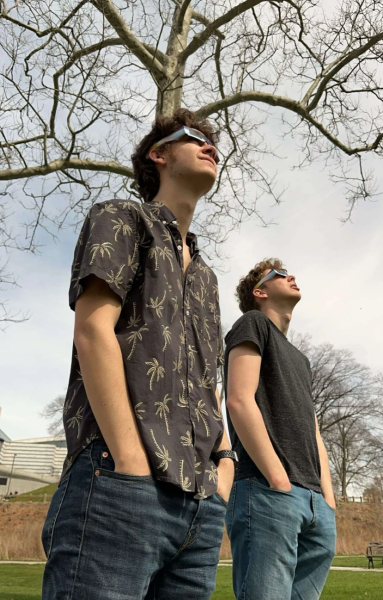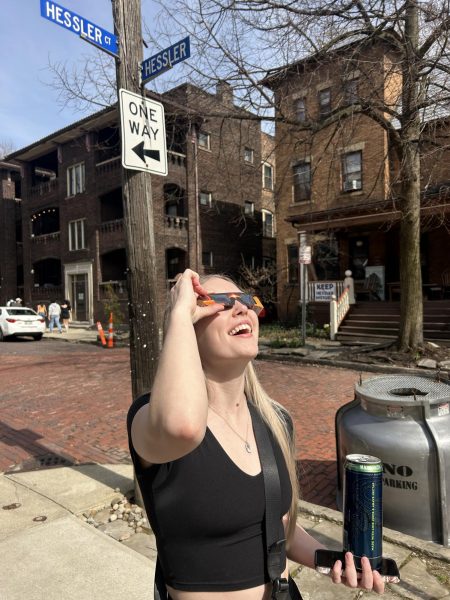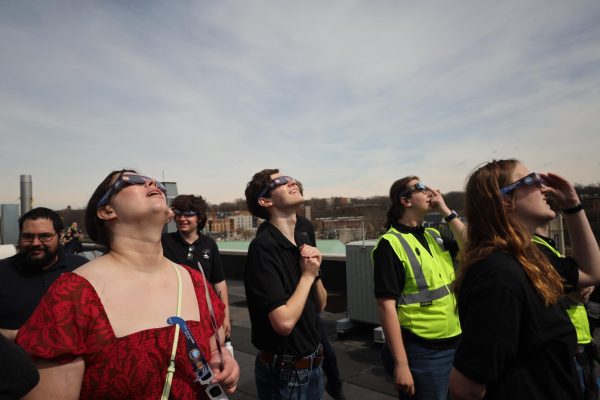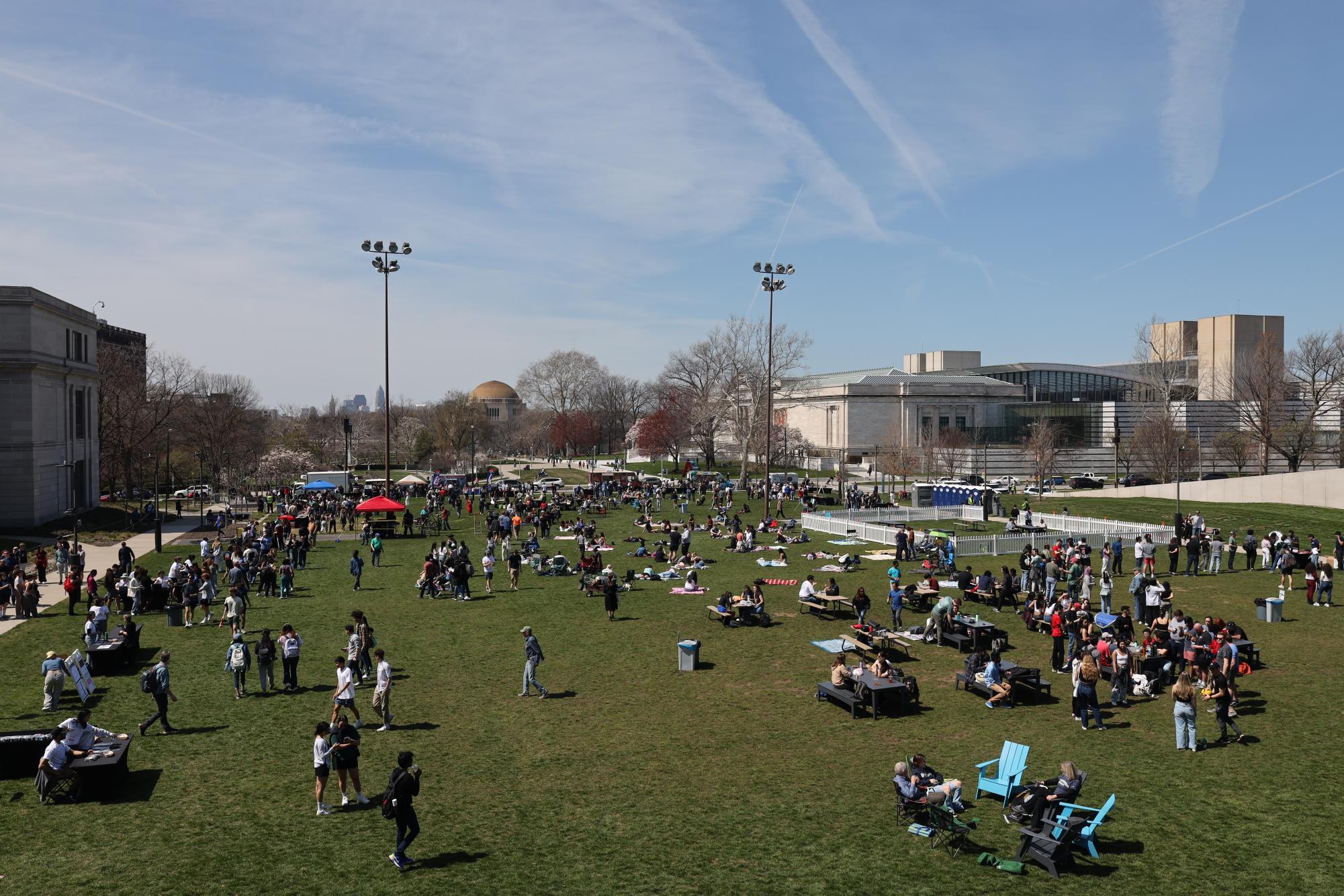Campus was overflowing with excitement as countless people stood outdoors and eagerly awaited the solar eclipse’s totality, the brief period when the Moon completely obscures the Sun. During a campus-wide day off, over a thousand Case Western Reserve University students, professors and community members took to Freiberger Field on Monday, April 8 for the Solar Eclipse Viewing. The event was put on by the University Program Board and Students for the Exploration and Development of Space (SEDS), and it featured numerous student organizations tabling and performing before and after totality.
The watch party began at noon. Music played throughout the afternoon, and there were many tables for everyone to explore. Eclipse glasses were readily available and necessary for viewing the Sun before and after totality.
The students from the astronomy department brought a big telescope through which people could view the Sun. Its resolution was strong enough that even sunspots were visible. Third-year math, physics and astronomy major Ananda Smith, the treasurer of SEDS, said, “the image [of the Sun is] projected onto the screen so that you don’t have to look through the telescope because that’d be really dangerous if you did.”
 CWRU Lego Club had a raffle and a table where students could build their own rockets. Big Games Club held a scavenger hunt, and there was a trivia wheel where students could answer questions for prizes. There were also tables where students could make suncatchers and pinhole cameras.
CWRU Lego Club had a raffle and a table where students could build their own rockets. Big Games Club held a scavenger hunt, and there was a trivia wheel where students could answer questions for prizes. There were also tables where students could make suncatchers and pinhole cameras.
On the side closest to Kelvin Smith Library, a massive line of students formed to grab custom eclipse T-shirts. Those who chose not to wait in line or came too late could also get a T-shirt as a prize at the trivia wheel.
The grass on East Boulevard was lined with tables where students could grab free food and snacks. The road right behind them had several food trucks, including one run by CWRU’s very own Bon Appétit.
Those who understood the stages and sights of an eclipse came ready to see what they had studied. Third-year engineering physics major Luke Adelman said, “I’m looking forward to the kind of phenomena that you see as the eclipse is starting and stopping: the Baily’s beads and the other fringe effects. I’m just really excited to watch that transition happen.”
Baily’s beads are a phenomenon that occurs in the moments before totality as scattered bits of the Sun’s photosphere are still visible behind the Moon, causing a line of light beads to appear.
Other students were eager to see the amazement of everyone present. Fourth-year student Summer Carver said, “me being a physics major and being an astronomy minor, I had been excited about this event for the past year. And seeing everyone get equally as excited as me has just been super duper nice.”
 The watch party began with clear skies, but by 1 p.m. some thin clouds had moved in, beginning to obscure the Sun. The clouds remained in front of the Sun for the duration of the eclipse, though they did not impede the view of the Sun through eclipse glasses.
The watch party began with clear skies, but by 1 p.m. some thin clouds had moved in, beginning to obscure the Sun. The clouds remained in front of the Sun for the duration of the eclipse, though they did not impede the view of the Sun through eclipse glasses.
At 1:59 p.m. the partial eclipse began. For over an hour, the Moon slowly crept in front of the Sun, creating a shrinking yellow crescent to onlookers who peered through eclipse glasses. The temperature noticeably plummeted in the minutes leading up to totality. Freiberger was completely packed with eager spectators, most of whom had never seen totality before.
At 3:13 p.m. the final vestiges of the Sun vanished as the crowd cheered and clapped in astonishment: For the first time since 1806, Cleveland was shrouded in darkness in the middle of the day. The Sun’s white corona shone around the black Moon for nearly four minutes and could be viewed safely without eclipse glasses. A visible red dot called a “prominence” radiated at the bottom of the Sun. The horizon was filled with a yellow layer of light resembling a 360-degree sunset. Below the Sun and to the right, Venus was clearly visible as a bright white dot. At 3:17 p.m., the sky lit up again as the bottom of the Sun shone with blinding force—it was time to put the glasses back on.
“Totality of the eclipse is the greatest thing I’ve ever seen,” said third-year physics major Joey Rodriguez, echoing the sentiments of many who were awestruck by four-minute experience
 Third-year computer science major Asya Akkus was especially moved by the sight of the eclipse: “I’m not even a really religious person, and seeing totality I just went down on my knees and I started praying. It was probably the most beautiful thing I’ve seen in my life.”
Third-year computer science major Asya Akkus was especially moved by the sight of the eclipse: “I’m not even a really religious person, and seeing totality I just went down on my knees and I started praying. It was probably the most beautiful thing I’ve seen in my life.”
Some students anticipated the eclipse for a while, and the experience lived up to the hype. “I put this on my calendar since July 20, 2023, and I’ve been waiting for this moment for probably a year. And I’m so glad I got the opportunity to see it in Cleveland, Ohio,” third-year political science and psychology major Mira Sethi said. “I’m so excited that I got to experience it with my friends, and I got to see it with my glasses with good protection.”
Many students reported that they saw the solar eclipse that passed over the continental United States on Aug. 21, 2017 but were unable to see its totality. Steven Johnson, a second-year mechanical engineering student from the University of Maryland, said that the partial eclipse he saw in California in 2017 doesn’t compare to this one. He said, “to see complete darkness was just surreal.”
Starting at 3:45 p.m. Case In Point, Undivided, Klover CWRU, Dhamakapella, the Korean Student Association and Solstice performed before an excited crowd. The partial eclipse ended at 4:29 p.m. and the performances concluded around 4:40 p.m.
 The Solar Eclipse Viewing was an extraordinary experience for the CWRU community and tens of millions of others in North America. CWRU students will have to wait until 2444 to see another total solar eclipse on Freiberger. Summarizing the experience of totality, Akkus said, “It was otherworldly. It was actually breathtaking.”
The Solar Eclipse Viewing was an extraordinary experience for the CWRU community and tens of millions of others in North America. CWRU students will have to wait until 2444 to see another total solar eclipse on Freiberger. Summarizing the experience of totality, Akkus said, “It was otherworldly. It was actually breathtaking.”
Additional reporting contributed by Director of Design Auden Koetters, Social Media Content Creator Kethan Srinivasan and News Editors Téa Tamburo and Zachary Treseler.



